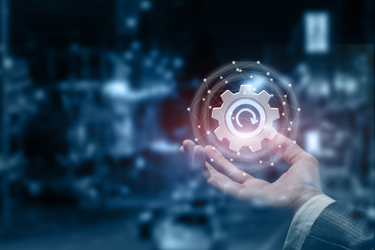Streamlining Utility Operations With Digital Visual Elements
By Chad Hall, Panasonic System Solutions Company of North America

This past year has been full of unexpected interruptions, bringing the importance of technology use in disaster preparedness and response to the forefront in 2021 and beyond. According to Deloitte’s 2021 Power and Utilities Industry Outlook report, 29 percent of power and utility experts think that utilities should primarily focus on digital strategies in 2021. With the world becoming more connected by the minute, it’s important to ensure that field and utility workers are supported with the most effective technology solutions. By investing in mobile solutions equipped with the latest capabilities such as AR and digital twin modeling, workers have real-time access to information they need to effectively complete their job.
AR For Reliability
From maintenance to repairs, the utility industry relies on workers in the field to maintain the energy grid and immediately address issues to avoid downtime. Since many workers don’t have access to real-time data in the field, work orders quickly become multistep processes as they travel between the office and the field to ensure they have the right information to complete the task. Augmented reality (AR) streamlines this process, allowing workers to add audio-visual elements via mobile devices and specifically created AR software applications. AR can boost operational efficiency, improve customer service, shorten repair times, reduce training expenses, and lower accident risks. Grid operators are starting to pay attention to the growing potential of AR, requesting that suppliers comply with their AR needs and requirements in the field. While it has not hit quite hit the mainstream, suppliers need to invest in the technology to run these applications as customer demand rises.
To successfully set up an AR system, suppliers need a designated computer, an AR camera, a reliable software platform, two data sets within the Geographic information system (GIS), and a high accuracy GPS receiver and antenna. By combining all of this technology, workers can artificially map the area they’re servicing, allowing for proactivity and more informed maintenance decisions.
Digital Twin Modeling For Preventative Maintenance
A digital twin is a virtual representation of an object or system that spans its life cycle, is updated from real-time data, and uses simulation, machine learning, and reasoning to help with decision making. It uses real-world data to create simulations that can predict how a process will perform. When paired with AR, digital twin modeling uses various data sets to convert map views into real-time ground views so utility workers can see what they cannot see with the naked eye, including underground and inside utility management facilities. This capability allows field workers to analyze data and monitor systems to proactively address challenges before they result in downtime. While utility companies already have their underground and aboveground facilities mapped out, digital twin modeling allows workers to register changes in real-time.
For example, a gas company is on-site digging a trench and rupture a gas line. While previously, the company had no way of avoiding this potential issue, with digital twin technology, they can now see underground in 3D mode. This capability allows companies to identify and avoid gas lines before disaster strikes – avoiding threats to the public while maintaining the system and worker safety. Workers also can improve their disaster preparedness response times and put measures in place to prevent them from happening in the first place. While every incident can’t be avoided, this technology gives a real-time 3D representation of the field – allowing workers to catch potential issues as they happen.
Looking Ahead
With advanced applications of technology, the utility industry can bring reliability and quality assurance to in-field services. From gas leaks to pipe malfunctions, implementing these solutions not only streamlines operations but also prioritizes proactivity. As we look to the future of fieldwork, it’s clear that AR will continue helping utility professionals work smarter and faster. By embracing the technology needed to address customer needs, the industry shifts into a new digital era focused on efficiency and real-time data-driven decisions.
About The Author
Chad Hall is the Strategic Account Manager of Utility & Enterprise Mobility Solutions for Panasonic System Solutions Company of North America.
